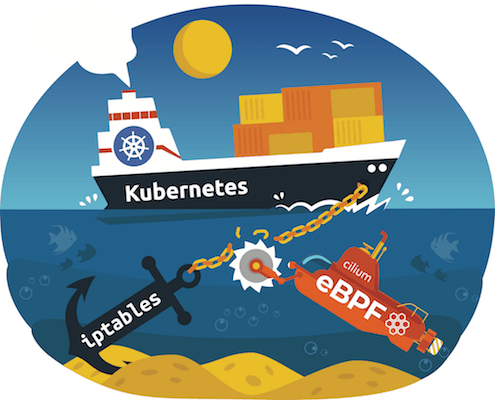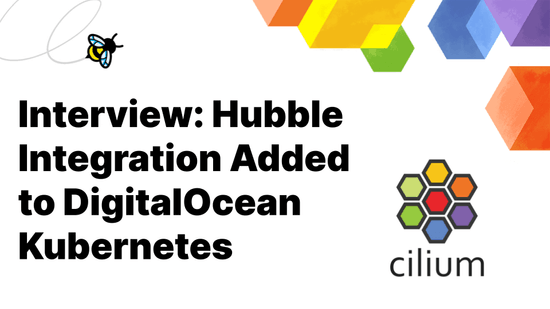Cilium 1.0: Bringing the BPF Revolution to Kubernetes Networking and Security

The last couple of months have been tremendously exciting for everyone working on Cilium and BPF. We have witnessed a fast growing community of Cilium users as well as the rapid increase of BPF usage and development with companies such as Google joining the existing already strong BPF community of engineers from Facebook, Netflix, Red Hat and many more. Possibly the strongest signal on the success of BPF has been the decisions of the Linux kernel community to replace the in-kernel implementation of iptables with BPF.
All of this has allowed us to advance BPF quickly and mature the Cilium project very effectively. Our warmest shoutouts go to everyone who has joined us on this incredible journey since we initially announced Cilium at DockerCon 2017. Your support in the form of contributing code, providing feedback and spreading the word has been incredible.
Cilium 1.0: Stable API and LTS releases
Today, we mark the release of Cilium 1.0 and assign the first ever stable release number. Starting with this release, we will also provide all of the guarantees and processes required to run Cilium in production environments:
- API stability with upgrade and downgrade compatibility guarantees.
- Stable releases with LTS support for production use.
- Well defined process to handle security relevant bugs and incidents.
- Responsive support on Slack and GitHub as well as defined processes to report bugs and request features.
Why Cilium?
This blog post focuses on the functionality provided by the Cilium 1.0 release. We have published a separate post that provides additional background and use cases as well as a preview of the service mesh/sidecar acceleration work.
Cilium - Rethinking Linux Networking and Security for the Age of Microservices
What is Cilium?
The following list describes the functionality that Cilium provides as of 1.0. You can find more detailed descriptions in the functionality overview section of the Cilium documentation.

-
Highly efficient BPF datapath: BPF is the underlying Linux superpower doing the heavy lifting on the datapath by providing sandboxed programmability of the Linux kernel with incredible performance. Read more about the powers of BPF in this blog or in the BPF reference guide.
-
Fully Distributed: All datapath elements are fully distributed across the cluster and run at the most efficient layer in the operating system on each cluster node.
-
Service Mesh datapath: BPF allows us to build the ideal dataplane for the fast growing service mesh space. Cilium 1.0 already provides transparent injection of proxies such as Envoy. Future versions of Cilium will provide acceleration of sidecar proxies. We have published a set of early sidecar proxy performance benchmarks
-
-
CNI and CMM plugins: The CNI and CMM plugins enable integration with Kubernetes, Mesos, and Docker to provide networking, load balancing and security for containers.
-
Network Security on both the Packet and API level: Cilium combines packet based network security and segmentation with transparent API aware authorization to provide security for both traditional deployments and evolving microservices architectures.
-
Identity Based: Instead of relying on source IP addresses to identify workloads, Cilium encodes the workload identity in every packet to provide highly scalable security. This portable design allows the identity to be encoded in any IP based protocol and is aligned with upcoming concepts such as SPIFFEE or Kubernetes' Container Identity Working Group.
-
IP/CIDR Based: If identity based enforcement is not applicable, IP/CIDR based security can be used to control access. Whenever possible, Cilium offers abstractions to avoid hardcoding IP addresses in security policies. An example of this is the ability to define policy based on Kubernetes service names.
-
API Aware Security: The increasing usage of protocols such as HTTP/REST, gRPC and Kafka renders IP and port based security insufficient. The built-in awareness of a growing list of API and data store relevant protocols allows enforcing least privilege security at the right granularity.
-
-
Distributed and Scalable Load Balancing: High performance Layer 3-4 load balancer using BPF for service to service connectivity with support for flow hashing and weighted round-robin. The BPF hashtable based implementation provides O(1) performance which means that the performance will not drop as you increase the number of services. The load balancer can be configured in two ways:
- Kubernetes Service Implementation: All Kubernetes ClusterIP services will be automatically implemented in BPF to provide a highly scalable alternative to kube-proxy for in-cluster load-balancing.
- API driven: For more advanced use cases, an extensive API is available to directly configure the load-balancing component.
-
Simplified Networking Model: Decoupling security from addressing simplifies the networking model dramatically: A single layer 3 network space provides the connectivity for all endpoints which are then segmented and secured using the policy layer on top. This simplicity tremendously helps scaling and troubleshooting. Networking can be configured in two modes:
- Overlay/VXLAN: The simplest integration that allows carrying workload identities for any IP based protocol. Hardware assisted VXLAN offloads ensure close to native performance.
- Direct Routing: Direct routing allows delegating routing to an existing networking component such as the native Linux routing layer, IPVLAN or a cloud provider router.
-
Visibility/Telemetry: Similar to policy, visibility is provided on both the network packet and API call level. All visibility information includes rich workload level metadata such as container/pod labels and service names, instead of just IP addresses and port numbers.
- Microscope: Microscope provides visibility of security and forwarding events at cluster level with the ability to filter events based on labels, security identities and event types.
- BPF-based High Performance Monitor: The high performance BPF perf ring buffer, designed for tracing millions of applications events per second, provides a highly efficient reporting channel which, combined with the programmability of BPF, allows extracting metrics and visibility at will with minimal overhead.
- API driven: All visibility is provided via APIs and can be fed into existing systems.
-
Troubleshooting:
- Cluster Connectivity Health: Cilium periodically monitors the cluster connectivity including latency between all cluster nodes to identify faulty nodes and underlying network issues.
- Prometheus Metrics: Metrics allow integrating Cilium into your existing monitoring dashboards for efficient monitoring of Cilium.
- Health Checks and Status overview: Reliable health checks and component status overviews help quickly assess the health of all components and pinpoint problems.
- Diagnosis and Reporting tools Various tools to assist in the automatic detection of common problems and in the collection of information for bug reports.
Getting Started
Cilium is simple to install and use, in particular on Kubernetes:
vim cilium.yaml [provide etcd or consul address]
kubectl create -f cilium.yaml
kubectl create -f demo_app.yaml
kubectl create -f http_policy.yaml
kubectl exec -ti xwing-68c6cb4b4b-red5 -- curl -s -XPUT deathstar/v1/exhaust-port
Access denied
The above example is a summary of the hands-on minikube tutorial that walks through applying a HTTP aware network policy step by step. More tutorials can be found in the getting started section.
For further information on installing Cilium, see the Kubernetes Quick Installation Guide or refer to the full list of installation guides
The Roadmap Ahead
Cilium 1.0 is an exciting milestone for all of us but we are already deep into the planning of Cilium 1.1. So what is on the roadmap for 1.1 and beyond?
-
Multi Cluster Service Routing: The simplicity of Cilium’s networking model and the decoupling of addressing and policy allows for easy expansion across clusters. With this expansion, Cilium will start supporting Kubernetes service routing across multiple clusters without requiring complex proxy or Ingress solutions while providing the full set of identity based and API aware security.
-
Integration with OpenTracing, Jaeger and Zipkin: The minimal overhead of BPF makes it the ideal technology to provide tracing and telemetry functionality without imposing additional system load.
-
Policy support for additional API protocols: We already have several additional application protocols in mind that we will support in future releases to further improve security.
-
CRI support: Repeatedly requested by various members of the community, we are looking forward to supporting CRI to properly abstract the container runtime.
-
Non container workloads: The BPF datapath is not limited to container abstractions, it just happened to be the first use case we focused on. Future versions will provide APIs and documentation on how to integrate with native Linux tasks, VMs and how to bridge the identity based security space to existing worlds using IP addresses that cannot be migrated.
You can find the details of the 1.1 release planning in this github issue. Feel free to comment or open GitHub issues if you would like to see particular functionality in future Cilium releases.


